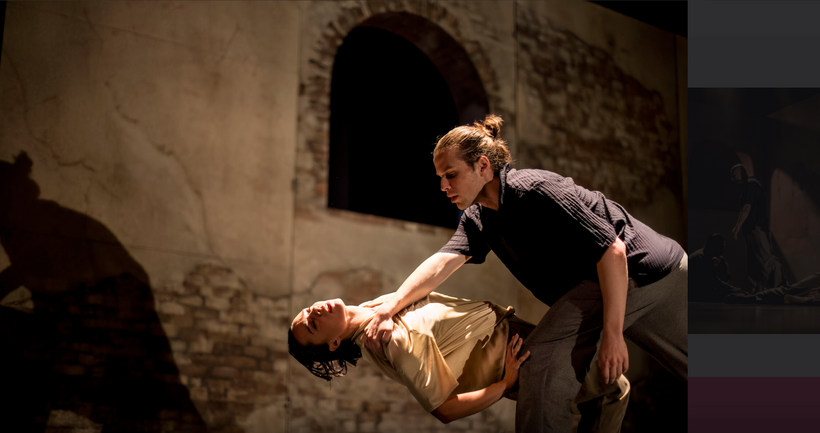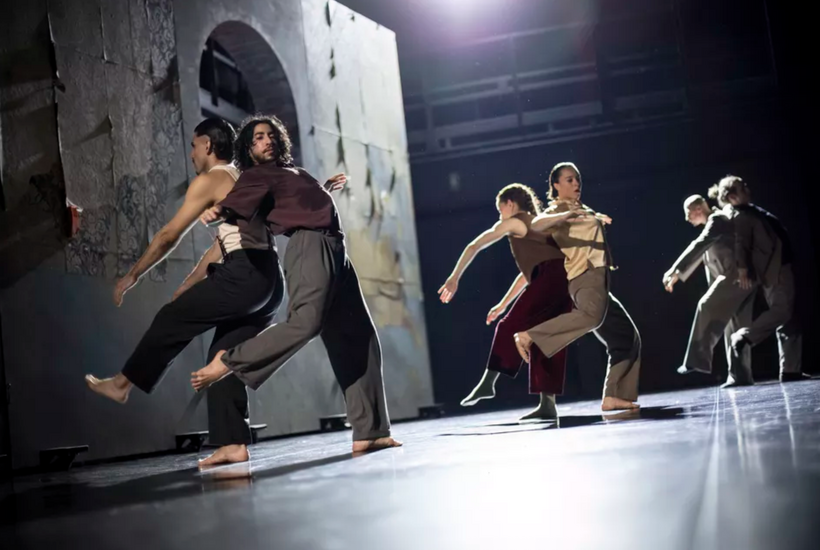Although this is a highly renowned and high-quality ensemble, I consider it a miracle in the Czech context. They also have dance halls in Libeň at their disposal, where they train and rehearse. The members of the ensemble lead movement workshops and the ensemble participates in international festivals. This year, they were at the Edinburgh Festival Fringe, where British and foreign critics praised them for their production Panoptikum.
Emilie Leriche and Pascal Marty testify about alienation, misunderstanding, and separation. Original, but not always
The premiere of Your Ghosts, My Shadows took place at the Komedie Theater, home to the dance company of Czech choreographer, teacher, and director Lenka Vagnerová. It should be mentioned that Lenka Vagnerová and Company has been incredibly lucky for several seasons now. They have at their disposal a permanent stage of the Prague City Theatres, where they regularly perform a diverse repertoire of productions by both Lenka Vagnerová and foreign guests. Last theatre season, they began with a production of Edivaldo Ernesto's Mystical Self, which definitely doesn’t leave you indifferent.
Intensive collaboration
The premiere of Your Ghosts, My Shadow was created by two experienced dancers and choreographers, Emilie Leriche and Pascal Marty, who have worked with many well-known contemporary choreographers such as Yoann Bourgeois, Marina Mascarell, Sidi Larbi Cherkaoui, Ohad Naharin, Damien Jalet, Sharon Eyal, and Saburo Teshigawara during their rich careers. They currently work as independent artists and, in addition to their active dance careers, both create original choreographies. Emilie Leriche has worked for Nederlands Dans Theater II in Den Hague, Scapino Ballet in Rotterdam, and German and Swiss ensembles. Pascal Marty has created choreographic pieces for GöteborgsOperans Danskompani and works with independent companies and with film.
Lenka Vagnerová approached them both about collaborating two years ago. She knows them well from their time together at the Swedish company, where she herself created and taught. In the spring of this year, she invited them to an intensive workshop, which was, to a certain extent, the start of the creation of dance material for the upcoming choreography Your Ghosts, My Shadow.
Leriche and Marty devoted a lot of time to choosing the theme, as is evident from the work presented, their deliberation, careful preparation of the script, and search for choreographic material. Both have a broad outlook and are also involved in film, photography, and the visual arts. They invited their French friend Wolff Bergen, who lives in Sweden, to collaborate on the music. They seem to understand each other well, because the composer and sensitive musician admirably complements all the situations that unfold in the production. His composition has a cinematic character, with many acoustic instruments, but also a clear soundscape of noises and sounds. The music suits the dancers perfectly. I think they dance the theme with ease and fully convey the atmosphere, which is not always light-hearted.
To stay or to leave
Your Ghosts, My Shadows deals with themes of leaving, abandonment, and staying. It is about the eternal dilemma of whether to stay at home or leave, to be here or somewhere far away from the safety of established habits and close relationships. Every departure, whatever the reason, is accompanied by uncertainty, anxiety about the unknown, and constricting thoughts. Sometimes our departure hurts others. We are actually present in real space and at the same time in another space, where we would like to be, but are not. The desire to leave and try something new drives us away, but it is the people close to us who force us to stay.
At first, the authors thought they would create two separate choreographies on a common theme. After many discussions, they agreed to create the performance together and wrote a script in which they used their never-sent letters. Some of the letters are testimonies to secret feelings, emotions, and hidden secrets. The story takes place between a mother, father, and children. The confrontation between their relationships is quite unclear at the beginning, but the dance performance is so powerful and dynamic that it was not important for me to understand everything. The choreographers work with hints, poetic symbols, and stories from the past and present. Emilie Leriche deals with the past in her parts, while Pascal Marty focuses on the present moment and family members who have passed away. These phases are distinguished by lighting, each with its own colour—one cold, the other warm. Karel Karlos Šimek's lighting design perfectly supports the director's intention.
To understand the production more precisely, including the motivations and decisions of individual characters, and to distinguish between the movement styles of each of the choreographers, it is necessary to see it more than once. In any case, it is clear that the choreographers divided the individual plot situations and then combined them into a single whole.
The wall that divides
For both artists, even though their styles differ, it is important where they are located in space. How space limits and influences them. They devote themselves in a poetic form to the body, space, and the image they create.
The space and the action are co-created by a movable high wall with a single window. The wall is actually a co-player in the production and determines where we are. It is quite damaged on both sides, with old torn wallpaper and fallen plaster visible. The panel moves across the stage, quickly changing the environment and even creating a closed house. (Although the choreographers designed the set, this is not mentioned in the production credits.)
There are two important props on the wall: a telephone with a handset attached to the wall and a mailbox. They are quite determining for the plot. The ringing of the outdated telephone and the limited space for making calls evoke the theme itself, where someone is calling from somewhere outside far away, and we find ourselves in a certain isolation. Most situations here evoke alienation. While on the phone, the dancers talk, some in Czech, some in English, the texts are short and concise. At times, they are full of reproaches, unanswered questions remain in the air. (Where are you, why don't you answer; I have to stay here and take care of my dad; I can't stay here, the regime here is suffocating me.)
The situation with the phone evoked many personal experiences for me. How we used to be unable to call somewhere or the phone was "dead." How futile it was to try to get a separate line. Similarly, writing letters and notes. In the age of the internet and cell phones, this seems completely nonsensical, even unbelievable. And yet, receiving a handwritten letter in a sealed envelope is something incredibly beautiful and mysterious. At times, it is difficult to accurately assess individual relationships; they are more like fragments, parts of dialogues, dance duets, and group choreography. The movement style seems very natural, unforced, and yet in some ways completely new, original, I would say unspent. Certainly, because all the performers are young, full of energy and ideas.
In some scenes, the dancers stand with their backs to each other, as if they want to leave, to part ways, but they can't. They try to do so also by acrobatically carrying each other on their backs. This imposes certain limitations on their movement. Contact and touch have their place in the choreography, even though there is no intimate relationship between the partners. It is not directly a technique of contact improvisation, but in some passages the movement vocabulary resembled it. Certain elements are quite physically demanding in terms of maintaining balance, falling over, or sliding over a partner. The choreography is definitely designed for technically skilled dancers.
In fact, everyone performs beautiful solo dance acts. I was particularly impressed by Paula Morejón García and the dynamic Lukas Lizama Garrido, who dances expressively in silence without music, perhaps as a harbinger of a sad ending to a very sad story. Adam Sojka remains abandoned and alone. He also excels in his acting, as does Jana Hampl Maroušková, who presumably plays the role of the mother. The other dancers, Leo Terris and José Guzmán, also bring maximum tension, and it can be said that the production has no dull moments.
Written from the premiere of the 14 September 2025, at the Komedie Theater, Prague.
Your Ghosts, My Shadows
Written and Directed by: Pascal Marty & Emilie Leriche
Choreography: Pascal Marty & Emilie Leriche in collaboration with the dancers
Sound Design / Original Score: Wolff Bergen
Costume Design: Simona Rybáková (creative collaboration Barbora Kotěšovcová)
Light Design: Karel Šimek
Performers: Adam Sojka, Leo Terris, Lukas Lizama Garrido, Jana Hampl Maroušková, Paula Morejón García, José Guzmán
Lights: Jan Hugo Hejzlar
Sound: Eva Svobodová
Production: Soňa Hájek Bartková
Costumes/props / stage production: Monika Jonášová
Photo: Vojtěch Brtnický
Staged at: LV&C_STUDIO8, Komedie Theatre
Producer: Lenka Vagnerová & Company
Co-production: Prague City Theatres
Supported by: Ministry of Culture, City of Prague






